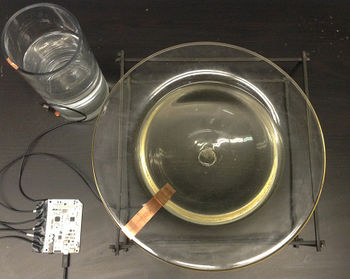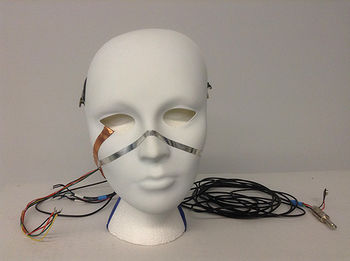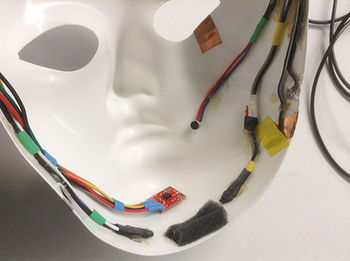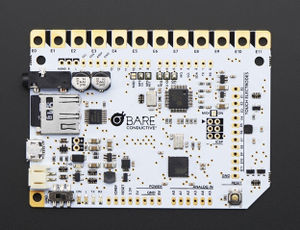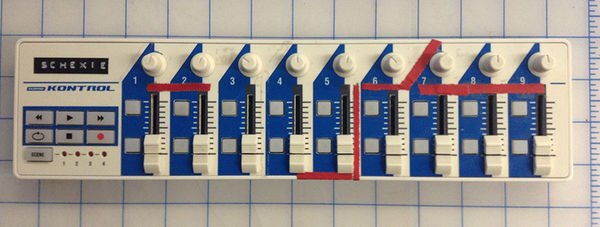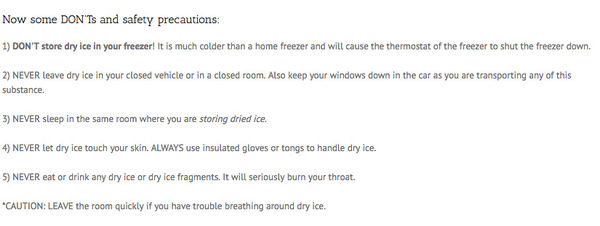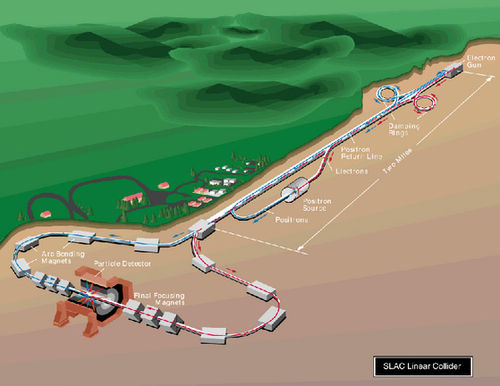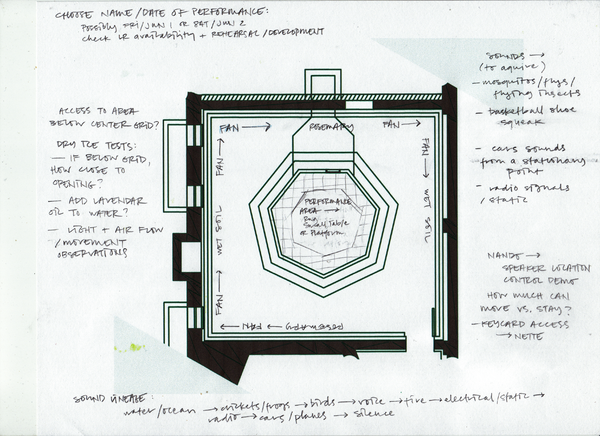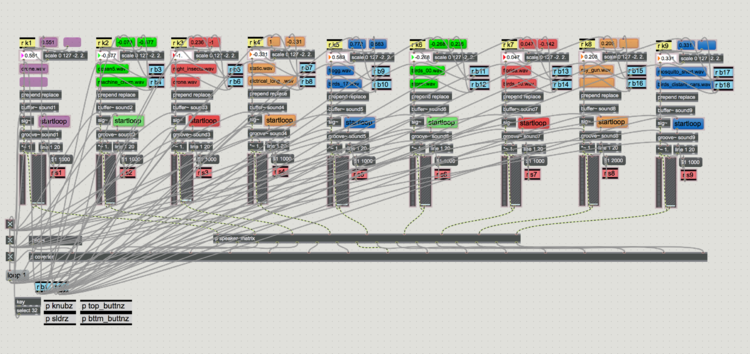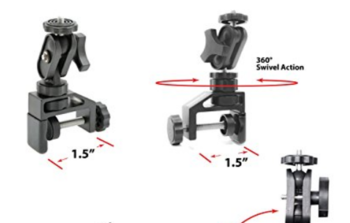Difference between revisions of "Ritualistic Performance System Research"
| Line 439: | Line 439: | ||
[https://www.amazon.com/gp/product/B000ABB4HC/ref=oh_aui_detailpage_o04_s00?ie=UTF8&psc=1 PEDCO UltraClamp] | [https://www.amazon.com/gp/product/B000ABB4HC/ref=oh_aui_detailpage_o04_s00?ie=UTF8&psc=1 PEDCO UltraClamp] | ||
| + | |||
| + | |||
| + | '''Dry Ice:''' | ||
| + | The dry ice component ultimately caused me a lot of duress and in the end felt like an arbitrary gesture. I was unable to work at the scale I would have liked without having to spend a ton of extra money to combat the ventilation system under the heptagon grid. I suppose I felt obligated to incorporate it somehow after spending so much time researching and sourcing the material, but am cognizant of its kitschy nature and feel unresolved around its use in this iteration of my performance research. With that said, I love the gurgling sound of the dry ice in water and would be keen to amplify and work with the sound in some form if I continue to work with dry ice in the future. | ||
Revision as of 12:27, 18 June 2018
Performance Image Courtesy of Dave Kerr
Post-human Incursion is a site-specific performance piece developed for the Listening Room at CCRMA. Inspired by the writing of Bernie Kraus and the work of Pauline Oliveros, the piece functions as a futuristic reflection on the evolution of sound across species, while using spacialized and manipulated field recordings to create new sonic terrain.
Project Overview + Development:
Goal: To create a ritualistic performance system using spacialized audio signals, video, and real-time audio manipulation.
Background:
As part of continued research, I aim to pursue an audio/visual experience that combines spatialized field recordings, voice, video/light, and software. For this piece, I may continue to develop a proximity-based water sensor into the performance, using some sort of vessel(s), water, conductive tape, and a bare conductive microcontroller. The audio collection process will include listening, recording, and engaging with a series of natural and machine-made sounds. The piece will culminate in an audio/visual performance.
Possible Controllers:
WK1 -- Brainstorming + Testing
Performance Site -- Listening Room Okay to burn / use scents? -- No. Issues in the past. Dry Ice? -- Could be okay. Needs ventilation. Max capacity in Listening Room -- 15-20 people
To do:
Bare Conductive Touch Board + Water Sensor Testing in Max Arduino code + upload to Touch Board Max MSP/Jitter + Touch Board testing Add water sensor input to video mixer patch Collect Field Recordings Fire / Machines / Energy Facility / Electrical Drone Sounds
WK2 -- Testing + Collection
Water Sensor Testing in Max MSP/Jitter [1]
I managed to get data into Max from the Bare Conductive microcontroller. After a few minutes, the microcontroller seems to get overloaded and freezes. If I reload the Arduino code onto the board data starts to work in Max temporarily. This issue seems relatively consistent. My laptop also seems to be having trouble processing video and receiving data at the same time. The latency of sensor data into Max is painfully slow while video is running. Sensor response is proficient with no video processing.
I will need a new laptop. This is not a surprise.
Readings:
Keywords in Sound, Chapter 15, Resonance, by Veit Erlmann
"...the concept of resonance, having been derived from core epistemological virtues such as intuition, observation, and experiment, names the natural mechanism governing the interaction of vibrating matter, such as strings, nerves, and air. As such, resonance is the "Other" of the self-constituting Cartesian ego as it discovers truth (of musical harmony, for instance) and reassures itself of its own existence as a thinking entity. On the other hand resonance names the very unity of body and mind that the cogitating ego must unthink before it uncovers truth."
(Erlmann, page 177)
Keywords in Sound, Chapter 17, Space, by Andrew J. Eisenberg
"As a phenomenon that exists at once within and beyond perceiving subjects, sound cannot but reveal social space as an artifact of material practices complexly interwoven with semiotic processes and the 'imaginations, fears, emotions, psychologies, fantasies, and dreams' that human beings bring to everything (Harvey 2006: 279; see also Lefebvre 1991)."
(Eisenberg, pg 202)
The Soundscape: Our Sonic Environment & the Tuning of the World, R. Murray Schaffer, Chapter 12, Symbolism
"...water, the original life element, has the most splendid symbolism... a stream, a fountain, a river, a waterfall, the sea, each makes its unique sound but all share rich symbolism. They speak of cleansing, of purification, of refreshment, and renewal... It is symbolic of eternity... It is symbolic of change."
(Schafer, page 170)
"Without its tactile pressure on the face or body we cannot even tell from what direction it blows. The wind is therefore not to be trusted."
(Schafer, page 170)
"Modern man has sought to escape both the wind and the sea by encapsulating himself in artificial environments... The sounds of machines took on happy symbolism approximately 200 years ago, when it was realized that they could release man from his immemorial bondage to earth... power and progress... noise and power go hand in hand."
(Schafer, page 178-179)
To do:
Research options for new laptop (2015 Macbook Pro) + Stanford support
Mask controller into Max MSP/Jitter
Build simple looper
Edit field recordings
WK3 -- More Testing + Collecting
Simple Audio Looper Interface for Testing | Max MSP/Jitter + MIDI Controller:
I built a simple looper patch in Max in order to start manipulating and listening to field recordings from my recent sound hunts. Lately, I've been interested in machine sounds that have similar qualities as sounds from nature... similar to how cars sound similar to the ocean, or specific electrical resonances sound like cicadas and crickets.
audio test -- [2]
Readings:
"...the wind began to funnel down from the high southern pass, gaining more forces with each passing moment... The effect wasn't a chord exactly, but rather a combination of tones, sighs, and midrange groans that played off each other, sometimes setting strange beats into resonance as they nearly matched one another in pitch... strangely dissonant. While never unpleasant, the acoustic experience was disorienting."
(Kraus, pg 37)
The Great Animal Orchestra: Finding the Origins of Music in the World's Wild Places, Bernie Kraus
To do:
Research 2015 Macbook Pro SLAC audio recordings Research/Source dry ice Schedule Audium visit
WK4 --
Dry Ice Safety + Costs + Storage:
Searchworks Audio Finds:
Over the past week or so, I've been reading Art of Immersive Soundscapes which has revitalized my interest in musique concrète. Today I spent some time digging around Searchworks for online audio files/compilations/albums. In my hunt so far, I have found several resources that rely heavily on field recordings from nature to form audio compositions.
Here are a few:
Arctic Winds, Maggie Payne, 2010
Gateway Summer Sound: Abstracted Animal and Other Sounds Ann McMillan, 1979
Desert Winds: Six Windblown Sound Pieces and Other Works, Scott Smallwood, 2007
Highlights of Vortex, 1959, Smithsonian Folkways Recordings [2003]
SLAC Site Visit:
The tour of SLAC was a bit of a disappointment, but only because I didn't fully comprehend the context of the tour. I didn't realize our MFA tour was part of a larger public tour. Unfortunately, it was nearly impossible to record an audio sample without tour-talk and human ruckus. We only visited two small areas of the facilities, which didn't really give an overall impression of the scale of the accelerometer. There were, however, some exciting/uncomfortable oscillations coming from machinery that I would like to revisit under a more sound-oriented tour of SLAC. Outside of my sound hunt, it was astounding to hear about the some of the research taking place.
Floor Plan + Spacial Thoughts:
Light + Sound + Water Experiments:
To do:
Visit Listening Room Contact Nando for Listening Room Orientation Contact Nette for LR keycard access Book out LR rehearsal schedule Purchase 2015 Macbook Pro
WK5 --
I spent this week trying to iron out logistics. I met with Nando for a Listening Room orientation and am now considering the best way to execute signal routing in the space. Nando recommended I check out the Listening Room User Manual on the CCRMA website. For now, I'm thinking I'll address each speaker individually, rather than working with ambisonics. It sounds like I'll need to use Jack to interface with my computer. Speaking of computer, I bought a laptop! It should arrive next week. I was also able to arrange keycard access to the room and am still trying to pin down scheduling for rehearsal and official performance showtimes.
Possible Performance Date(s)/Times:
Friday, June 1 -- 4pm doors / 4:33pm performance
OR
7pm doors / 7:30pm performance
Saturday, June 2 -- 4pm doors / 4:33pm performance
AND
7pm doors / 7:30pm performance
WK6 --
Listening Room Mixing + Routing Research:
[6] Listening Room User Guide]
Projection/Lighting:
After visiting the Listening Room and looking at the infrastructure in place, I've decided not to do any screen-based projection that requires hanging additional material in the space. It will likely be a lot of work and ultimately be invasive to the experience. For now, I'd like to focus on the sound and possibly incorporate some simple caustic lighting elements. I'm considering options for reflecting light onto the grid that separates the floor from the lower level of the heptagon. This will require some sort of surface/screen that could easily be placed on the grid. I will need to be sure there is airflow so as not to cause any issues with the ventilation system which feeds into the lower level.
To do:
Install Max MSP/Jitter Set-up 22 Channel Routing in Max Source + Set-up RSVP Platform for Performance Contact Eoin for Listening Room Consultation Dry Ice Testing
WK7 --
Signal Routing + Listening Room Consultation:
My new computer finally arrived and I was able to schedule some time with Eoin to test routing options in the Listening Room. I've opted to use a 16ch analog interface and Jacknet, which will magically give me access to all 22 channels. I'll need to do more specific routing in Max but was able to get a signal out of my laptop and play audio over all 22 channels with minimal head-scratching and mysterious machine behavior. Eoin is awesome. I am consistently amazed at the generosity of the CCRMA community and am so grateful to have the opportunity to interact and learn from everyone.
Listening Room Booking + Conflicts:
I spoke to Matt Wright about any potential overlap with SLOrk rehearsal and general usage of the Listening Room. After our conversation, it seems best to bump my performance dates back one week so as to avoid any scheduling conflicts. Matt has also been kind enough to book out the space for me overnight so I will only need to set-up and teardown once. Wooo. Yay for CCRMA peeps!
RVSP Platform + Dates
I've decided to use Eventbrite for RSVP distribution/tracking. I've got a draft going and am seconds away from pulling the trigger. Just need to finish up my statement about the piece, and am currently wrestling with language and an official title. So close!
Friday, June 8th -- 7pm doors / 7:30pm performance Saturday, June 9th -- 4pm doors / 4:30pm performance
Dry Ice Tests:
Working with dry ice has been waaay more fun than I could have anticipated. With that said, I'm learning that the fun comes with a heftier fee than I originally thought... and it evaporates fairly quickly. A block of dry ice lasts for approximately 2 or 3 days at about $20 each. I've also discovered that the dry ice goes bananas until it's eaten up all of the oxygen in whatever water it's dropped into, at which point, the dry ice fizzles sadly with much less gusto. This happens fairly quickly. I think it will be fine for the performance, but it's possible I will need larger containers to house the water and dry. I've been most excited about projecting onto the dry ice and am thinking about ways to use the dry ice as the projection screen/surface for the performance.
To do:
Set-up Signal Routing Hierarchy in Max Publish + Distribute RVSP Invite Test Dry Ice in Listening Room Test Scent Machine in Listening Room Okay to Point Listening Room Projector Straight Down Onto Grid? Order More Fans? Dry Ice Containers / Scent Containers Edit new sounds
WK8 --
Testing + Rehearsal Findings:
I discovered that my USB MIDI controller will not work at the same time as the USB MOTU interface I am using to route sound in the Listening Room. This is a major problem. I've contacted Eoin for advice, and am hoping that using an ethernet connection will help resolve this issue. I'm also thinking about adding a second computer into the mix, mainly because of software limitations on my new computer. I'm not sure if this is going to cause a whole heap of other headaches, but mentioned my interest to Eoin. If it seems to crazy/unreliable I'll stick with one laptop.
Testing + Rehearsal Audio:
Dry Ice Testing:
My first rounds of dry ice tests in the Listening Room proved to be somewhat unsuccessful. The ventilation system below the grid sucks all of the dry ice vapors straight down and disburses them, making it difficult to see anything interesting happening. I tried placing a container of dry ice into a secondary container with edges slightly higher than the vessel holding the dry ice. This produced some really interesting behaviors, so I'm guessing I can do something similar at a larger scale -- hopefully filling the majority of the recess in the Listening Room floor.
I've been spending a good lump of time searching for containers to hold the dry ice. Whatever I use needs to be fairly large to help with the longevity of the vapors... but also not so large that it will be difficult to schlep it out of the room once the performance is over. There's also a slight chance that whatever I use to house the dry ice will be visible in some capacity, so I'm also trying to find something that is fairly simple in design... and also cheapish, since I will be covering a lot of area. I've been looking at all kinds of containers and haven't really found the right thing yet. I found something that will work, but I'm not very excited about it.
For the secondary 'container' I am thinking about building out a frame that will fit inside of the heptagon. I would then line the frame with a black tarp or some sort of black fabric, leaving a few inches between the frame and the interior edge of the heptagon for air flow.
Speaking of air-flow, the sound of the dry ice bubbling in the water is becoming a wonderful bonus in the soundscape of my performance. Listening to the dry ice is sort of like sitting by a babbling creek, so I could have asked for a more exciting and unexpected surprise.
Projector Testing:
Initially, I was thinking about using the projector that is already mounted in the Listening Room. After further examination, I realized that the throw will probably not work well for my purposes. I did some tests with one of the PICO projectors and it seems like it might work okay. It probably won't be the brightest, most vivid projection... but I think that will be okay in this case. The dry ice is awesome with even just a little bit of light on it.
I bought a few small clamp mounts for any of the tiny projectors that enter into the set-up. I should be able to mount the projectors fairly easily using the rigging system in the ceiling.
Project Statement:
Earth frequencies are the foundation of sound-making in communication and survival for all living creatures. Insects, birds, and humans have all evolved to make sound in accordance with the landscapes in which they dwell, yet humans increasingly suffocate the soundscape, turning a blind ear to the sonic residue of industry and electromagnetic poisons.
Post-human Incursion is a site-specific audio/visual performance that examines how natural order might adapt soncially to human impressions on the evolution of voice across species. Through the use of spatialized and processed field recordings, Post-human Incursion gestures toward a futuristic bending of familiar sonic terrain twisted by the influence of machinery. Post-human Incursion is a poetic attempt to prophesize what the future may hold in relation to the expressive abilities and survival of sounding creatures on Earth. Do birds sing differently now that they are encumbered with the ruckus of industrialized human existence?
To do:
Find door person USB MIDI controller does not currently work while running USB MOTU 16ch interface Can I use two computers -- x1 for mask / x1 for field recordings? Define performance zone / altar
WK9 --
Listening Room Tech:
There was some mystery unplugging of a bunch of stuff in the Listening Room, which was causing some strange/inconsistent behavior. With the help and head scratching of Eoin and Nando... the mystery has been solved and things seem to be relatively stable. Phew! My MIDI controller also seems to be behaving for the most part. I've been using a power USB hub, which seems to be doing the trick, although I have a feeling the USB port on my controller is starting to get a little loose. Hopefully, it hangs in there for the performances...
Dry Ice:
I'm still struggling with the dry ice component of the piece. I don't think I'll be able to work at the scale I'd like, mainly due to the cost of materials. I think I've found a solution on a smaller scale, but I'm not super excited about it. Because of the scale change, it's likely I'll need to abandon the projection component. Hard to say for sure at this point, but unless some miracle ah-ha moment happens much of the visual components of the piece will be far diminished from what I would like to do in an ideal world where I'm rolling in cash and have an absorbent amount of time.
SLOrk + Set-up:
SLOrk moves out of the Listening Room on Wednesday evening. This means I will be able to leave things set-up and start to deal with cables and placement. In the interim, I've been doing some small lighting test and think I have a fairly simple plan for lighting including the hallway leading up to the Listening Room.
Printed Program:
I'm nearly finished working on a program for the performances. I think I will alter my statement to better describe all of the adjustments I've had to make and use language to indicate that it's still a work in progress. I assume it's fine to print the program at CCRMA.
Sound:
At this point, I'm so buried in the piece that I can no longer tell heads from tails. I've introduced a piezo as part of the altar, and have been testing various vocal utterances. Compositionally, I'm not totally sure where the piece is at or how far away I've fallen from my original intent. Currently, the piece is leaning toward something more musical than I originally imagined. I've removed the glockenspiel recording and have been working with more of a droning sound that I recorded using a synth. There's a cohesiveness to the sound, but what I've been developing is seemingly less like a soundscape even though there is an abundance of field recordings incorporated into the work. I suppose I'm feeling a little confused and could use some time away from the piece for reflection, but as is the whole shebang is feeling arbitrary and far removed... but maybe I'm too immersed in the process to see/hear it for what it is?
To do:
Complete Program / Print -- Do I need a code for the printer? Still trying to find a door person Lighting + Set-up Rehearsal + Testing
WK10 --
Culminating Voice Configuration:
Ultimately, I opted not to use the sensors embedded in the mask and only incorporated the microphone into the performance system, combined with some generous filtering in Ablteon Live. The signal from the microphone was passed through a MOTU interface with access to 22 discreet channels in the Listening Room. My voice occupied channels 1-8 and a handful of channels in the ceiling and floor.
Piezo Instrument:
Because of the whole debacle with my laptop, I strayed away from experimenting with the Bare Conductive Touch Board and water in this instance. Instead, I incorporated the glass bowl from my conductivity tests to make an instrument that is comprised of a piezo, the glass bowl, metal, feathers, and software. I fed the signal into Ableton for the instrument input within the same patch as my mic. I was able to output both signals as two separate channels to the MOTU interface allowing me to route the instrument signal discreetly over the 22ch system. I chose to route the instrument to channels 1-8, and the center ceiling speaker.
Field Recording Manipulation:
For all of the field recordings I continued to use Max MSP/Jitter and a MIDI controller to manipulate and navigate recorded audio signals. Rather than processing the sound through filters, I built a system where I am simply manipulating the speed and direction of each recorded sample. Most sounds are configured to play at a rate well below half speed and are occasionally played backward.
In addition to the field recordings, I also recorded improvisational synthesizer sessions. One of the first synth recordings I made in my process used the glockenspiel voice. After some feedback, I questioned if the glockenspiel was pulling the piece in a more musical direction and whether or not I would be okay with that in relation to my interest in the evolution of sound and soundscapes. I decided I was okay with the piece becoming more musical but felt that the synth could better match the electrical and machine-made sounds already incorporated into the piece. I believe I ultimately used some sort of electric piano voice on the synth to create a droney, circular sound. Once the synth sound was in Max MSP/Jitter, I made the happy discovery that the drone sound was a friendly match with some mosquito buzzing already incorporated into the composition and committed to using the drone sound in the composition.
Video:
For the video, I used a looped recording of layered trees composed in Max MSP/Jitter, along with a Nano projector, a Rasberry Pi media player, and a fancy clamp that allowed me to mount the projector off of a speaker-arm in the ceiling. The Nano projector is battery powered with a long enough life that I didn't need to bother with any cabling or power routing to the projector.
Dry Ice: The dry ice component ultimately caused me a lot of duress and in the end felt like an arbitrary gesture. I was unable to work at the scale I would have liked without having to spend a ton of extra money to combat the ventilation system under the heptagon grid. I suppose I felt obligated to incorporate it somehow after spending so much time researching and sourcing the material, but am cognizant of its kitschy nature and feel unresolved around its use in this iteration of my performance research. With that said, I love the gurgling sound of the dry ice in water and would be keen to amplify and work with the sound in some form if I continue to work with dry ice in the future.
Performance Image Courtesy of Dave Kerr

